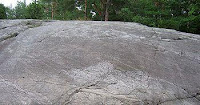While there are no shortages of Runestones about which I could write, more than 1,700 in Sweden alone, there are at least three aspects of this stone that are of particular interest. First is the fact that it is carved into a rock outcrop rather than on a standing stone. For this reason, it is sometimes referred to as the Ramsund carving, instead of stone. Looking at the image to the left, all that is visible on the rock are the glacial striations (scratch lines in the rock) from the Fennoscandia ice sheet that covered the region during the last ice age.
Upon closer look, we see reason number two why this Runestone is so interesting - the runic carving itself. A woman named Sigurd Ormsdottir (daughter of Orm), had the "bridge" made for her husband Holmgeirr's soul. It is likely that the bridge relates to Christian influence and the idea of a bridge to heaven or to the next life. Vikings believed in a next life as evidenced by many Viking ship burials that include all of the things that the person buried would need in his or her next life. Therefore, they may have found the idea of being able to build a bridge to it quite satisfying.
Although the scenes from Sigrud's story do not appear in order on the carving, I will go through them from left to right. The first image shows Reginn, Sigurd's foster father, decapitated among his smithing tools. Above that image and looking a bit like a dog, is Otr, Reginn's brother; he is a shape shifter. In the third scene, Sigurd is roasting the dragon's heart over a spit. The horse in the next image belongs to Reginn and it is carrying treasure. In the tree in the next scene, two birds warn Sigurd that Reginn will betray their reconciliation. Finally, there is an image, under the runic inscription, actually stabbing it from below. That is Sigurd killing Fafnir, Reginn and Otr's brother.
The Ramsund stone (or carving) is one of the coolest Runestones I've come across so far. Which one is your favorite? If there is one you'd like me to write about, let me know.



As you probably know, but your readers may not, the floor of The Culture House in Reykjavik (Þjóðmenningarhúsið) features a nice replica of this rune stone. This is the same museum that holds several originals of the Icelandic Eddas and Sagas. Similarly, the Swedish National Museum of History and Antiquities in Stockholm (Historiska Muséeet) also has a replica, as well as an interactive media show on the story, which runs every 30 minutes.
ReplyDelete